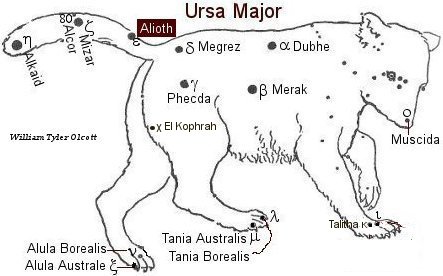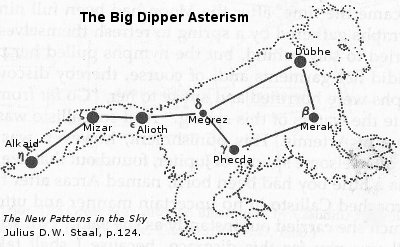| Fixed star: ALIOTH | |
| Constellation: Epsilon (ε) Ursa Major | |
| Longitude 1900: 07VIR31 | Longitude 2000: 08VIR56 |
| Declination 1900: +56.30′ | Declination 2000: +55.58′ |
| Right ascension: 12h 53m | Latitude: +54.18′ |
| Spectral class: A0 | Magnitude: 1.7 |
The history of the star: Alioth
from p.439 of Star Names, Richard Hinckley Allen, 1889.

Alioth, sometimes Allioth, seems to have originated in the first edition of the Alfonsine Tables, and appeared with Chaucer in the Hous of Fame as Aliot; with the 17th century German astronomer Bayer, as Aliath, from the 16th century French scholar Scaliger, and as Risalioth; with the Italian astronomer Riccioli (1598-1671), as Alabieth, Alaioth, Alhiath, and Alhaiath, all somewhat improbably derived, the 16th century French scholar Scaliger said, from Alyat [Allen notes: The syllable Al, in this word Alyat, is not the Arabic definite article (al usually means ‘the’)], the Fat Tail of the Eastern sheep. But the later Alfonsine editions adopted Aliare and Aliore — The Italian astronomer Riccioli’s (1598–1671) Alcore — from the Latin Almagest of 1515, on Al Tizini (Arabian astronomer, first half of 16th century)’s statement that the word was Al Hawar, the White of the Eye, or the White Poplar Tree, i.e. Intensely Bright; the 17th century English orientalist Thomas Hyde transcribing the original as Al Haur. The 15th century Tartar astronomer Ulug Beg had Al Haun, but the German astronomer Ideler (1766-1846), rejecting this as not being an Arabic word, substituted Al Jaun, the Black Courser, as if belonging to the governor, Al Ka’id, the star eta (η Alkaid), and its comparative faintness gives some probability to this conjecture. Assemani, however, said that on the Cufic globe it is “Alhut,” the Fish,— one of the many instances of blundering that the German astronomer Ideler (1766-1846) attributed to him.
The 17th century German astronomer Bayer also assigned to it the Micar, Mirach, and Mizar that we give to {p.440} eta (η Alkaid), and designated it as (Greek) Lagon, the Flank, and (Greek) Upozoma, the Diaphragm, as marking those parts of the Bear’s figure.
The Persian astronomer Al Biruni (973-1048 A.D.) said that it was Angiras (Angiras) among the Hindu Seven Rishis or Sages [identifying Kratu with the star α Dubhe; Pulaha with β Merak; Pulastya with γ Phecda; Atri with δ Megrez; Angiras with this star ε Alioth; Vasishtha with ζ Mizar; Bhrigu with η Alkaid. []]
In China it was Yuh Kang, the Gemmeous Transverse, a portion of an early astronomical instrument; while other stars between it and delta (δ Megrez) were Seang, the Minister of State.
In 1838 Sir John Herschel thought it the lucida (brightest star in a constellation) of the seven stars, but in 1847 that eta (η Alkaid) had taken its place. Franks, in 1878, considered epsilon (ε this star Alioth) the lucida, and that the sequence was epsilon (ε this star Alioth), eta (η Alkaid), zeta (ζ Mizar), alpha (α Dubhe), beta (β Merak), gamma (γ Phecda).
Star Names, Their Lore and Meaning, Richard Hinckley Allen, 1889].
Ursa Major has been called “the Bear with her train,” the “train” refers to the stars epsilon (Alioth, this star), zeta (Mizar), and eta (Alkaid) which mark the tail of the Bear. These three stars were also portrayed by the Arabs as “Mourners” around a Bier or coffin. The bier was marked by the Plough or Big Dipper stars; Merak (beta), Dubhe (alpha), Phecda (gamma) and Megrez (delta) on the body of the Bear. The coffin was followed by “Mourners” (the three stars in the tail; Alioth, Mizar, and Alkaid), as in the Arabic Banat Na’ash al Kubra, “the Daughters of the Great Bier”, and this constellation was seen as a funeral procession, attributing this title to the nightly slow and solemn motion of the figure around the pole. These mourners, the children of Al Na’ash, who was murdered by Al Jadi, the pole-star (Polaris), are still nightly surrounding him in their thirst for vengeance.

This star is located on the Bear’s tail which occurred when Jupiter lay hold of the tails of the two bears, Ursa Major and Ursa Minor, and lifted them up into the heavens by their tails. On the long journey, the tails stretched which explains why these bears have long tails unlike earthly bears.
The astrological influences of the constellation Ursa Major
Legend: Callisto, daughter of Lycaon, king of Arcadia, of whom Jupiter was enamored, became a follower of Diana on account of her love of hunting. Jupiter sought Callisto by assuming the form of Diana, and Juno (Jupiter’s wife) who discovered the intrigue turned Callisto into a bear. Angry that the bear was placed in heaven, Juno requested her brother Neptune never to let those stars set within his kingdom, and for this reason they are always above the horizon in Europe [never disappear below the horizon, it is always visible in the night sky, all night, every night, throughout the year]. To account for the length of the bear’s tail [because in reality bears don’t have tails], it is said that Jupiter, fearing her teeth, lifted her by the tail, which became stretched because of her weight and the distance from earth to heaven. [Robson, p.65.]
Influences: According to Ptolemy, Ursa Major is like Mars. It is said to give a quiet, prudent, suspicious, mistrustful, self-controlled, patient nature, but an uneasy spirit and great anger and revengefulness when roused. By the Kabalists it is associated with the Hebrew letter Zain and the 7th Tarot Trump “The Chariot.” [Robson, p.65.]
The astrological influences of the constellation Ursa Major given by Manilius:
“Now when, after completing a revolution round the pole, the Bear (Ursa Major) with muzzle foremost replaces her unceasing steps in her former tracks, never immersed in Ocean but ever turning in a circle, to those born at such a time wild creatures will show no hostile face, and in their dealings with animals these men will find them submissive to their rule. Such a one will be able to control huge lions with a gesture, to fondle wolves, and to play with captive panthers; so far from shunning the powerful bears that are the kin of the constellation, he will train them to human accomplishments and feats foreign to their nature; he will seat himself on the elephant’s back and with a goad will direct the movements of a beast which disgraces its massive weight by yielding to tiny jabs; he will dispel the fury of the tiger, training it to become a peaceful animal, whilst all the other beasts which molest the earth with their savageness he will join in friendship to himself; keen-scented whelps he will train…” [here the translator notes that eight pages have been lost] [Astronomica, Manilius, 1st century AD, book 5, p.357, 359]
“Now where heaven reaches its culmination in the shining Bears, which from the summit of the sky look down on all the stars and know no setting and, shifting their opposed stations about the same high point, set sky and stars in rotation, from there an insubstantial axis runs down through the wintry air and controls the universe, keeping it pivoted at opposite poles: it forms the middle about which the starry sphere revolves and wheels its heavenly flight, but is itself without motion and, drawn straight through the empty spaces of the great sky to the two Bears and through the very globe of the Earth, stands fixed, since the entire atmosphere ever revolves in a circle, and every part of the whole rotates to the place from which it once began, that which is in the middle, about which all moves, so insubstantial that it cannot turn round upon itself or even submit to motion or spin in circular fashion, this men have called the axis, since, motionless itself, it yet sees everything spinning about it. The top of the axis is occupied by constellations well known to hapless mariners, guiding them over the measureless deep in their search for gain. Helice (Ursa Major), the greater, describes the greater arc; it is marked by seven stars which vie with each other under its guidance the ships of Greece set sail to cross the seas. Cynosura [Ursa Minor] is small and wheels round in a narrow circle, less in brightness as it is in size, but in the judgment of the Tyrians it excels the larger bear. Carthaginians count it the surer-guide when at sea they make for unseen shores. They are not set face to face: each with its muzzle points at the other’s tail and follows one that follows it. Sprawling between them and embracing each the Dragon separates and surrounds them with its glowing stars lest they ever meet or leave their stations.” [Astronomica, Manilius, 1st century AD, book 1, p.27, 29].
The astrological influences of the star Alioth
In ‘the Tail of the Great Bear’, it is not supposed to have a strong influence on account of its great distance from the ecliptic. However, if Alioth is felt to make an impact, it is Mars like and of a destructive kind. Associated with the Sun, suicidal thoughts will be eminent in female cosmograms. Joined with the Moon, it will be an indication of possible danger during pregnancy and delivery. Amalgamated with possible non propitious planets, it will indicate fiascoes, bad fortunes within the family circle or within the profession or disappointments brought about by friends. It is advised not to include these findings in a prognosis, as these records were not borne out by later research. [Fixed Stars and Their Interpretation, Elsbeth Ebertin, 1928, p.54.]
References:
Fixed Stars and Constellations in Astrology, Vivian E. Robson, 1923].